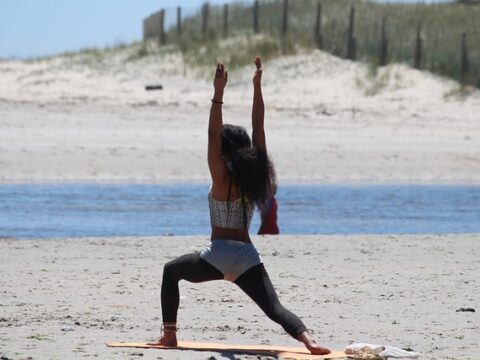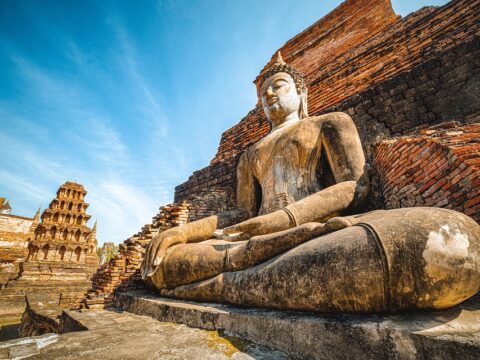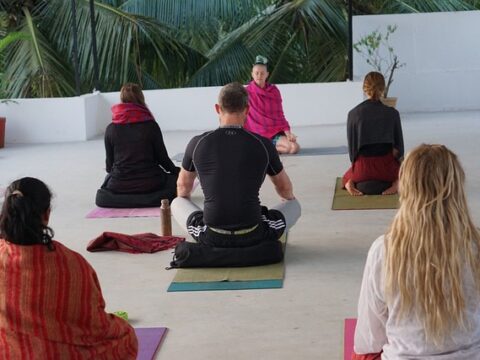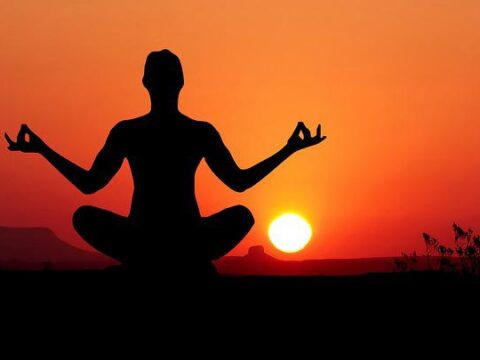Why yoga for good posture? Yoga is great for improving posture and fixing abnormal spinal curves. With regular practice and increased body awareness, you can build strength, flexibility, and alignment to maintain proper posture.
One of the first things to do is become more aware of your body. Pay attention to your posture throughout the day. Make little adjustments when you notice poor alignment. By tuning into your posture more, you can actively work to improve it.
Daily Yoga
Fitting yoga into your daily routine can really impact your posture. The poses are designed to strengthen and stretch muscles involved in good posture. Regular practice helps realign the body, fix muscle imbalances, and build a solid base for correct posture.
Yoga Benefits for Posture
Yoga has lots of benefits for better posture. It opens the chest and shoulders, easing tightness and tension that cause slouching. The poses also strengthen upper back muscles, helping to improve the hunchback curve of kyphosis. Yoga engages the core muscles too, which is key for proper alignment and preventing swayback from lordosis.
Additionally, yoga boosts body awareness and mindfulness. This allows you to notice and fix postural imbalances or habits. It promotes proper alignment, balance, and stability for good everyday posture.
Understanding Abnormal Spinal Curves
To tackle posture issues, it’s helpful to understand abnormal spinal curves. The two most common are kyphosis and lordosis.
Kyphosis is an exaggerated upper spine curve, causing a hunched upper back. Poor posture, weak back muscles or aging often contribute. Symptoms are rounded shoulders, forward head tilt, and upper back pain.
Lordosis is an excessive lower spine curve, resulting in swayback. Weak core muscles, poor posture, or pregnancy can cause it. A protruding abdomen, tilted pelvis and low back pain may occur.
Best Yoga Poses to Improve Posture – Kyphosis
For individuals with kyphosis, focusing on upper back bending poses can help reverse the hunchback curve and improve posture.
Benefits of Upper Back Bending Poses
Upper back bending poses, also known as backbends. It help to open up the chest, stretch the front of the body, and strengthen the muscles of the upper back. These poses improve spinal flexibility. They counteracting the rounding of the upper back associated with kyphosis.
They also help to improve breathing capacity by expanding the chest and reducing tension in the ribcage.
Specific Poses for Reversing Kyphosis
- Cow Face Pose (Gomukhasana): This seated pose stretches the shoulders and upper back, helping to open up the chest and improve posture.
- Balancing Table Pose (Dandayamana Bharmanasana): This pose strengthens the muscles of the upper back, core, and glutes, promoting stability and balance.
- Seated Twist Pose (Ardha Matsyendrasana): This seated twist helps stretch and strengthen the muscles of the upper back, improving spinal mobility and alignment.
Tips for Correct Form
When practicing upper back bending poses, it’s important to focus on proper form. Start by engaging your core muscles to support your spine and prevent excessive compression.
Keep your shoulders relaxed and down, avoiding any tension or strain. As you deepen into the pose, maintain a steady and smooth breath, and listen to your body’s limits.
Best Yoga Poses to Improve Posture – Lordosis
For individuals with lordosis, engaging the core muscles is crucial for reversing the swayback curve and promoting good posture.
Benefits of Engaging Core Muscles
Engaging the core muscles helps stabilize the pelvis, supporting proper alignment and preventing excessive arching of the lower back. Strong core muscles provide a solid foundation for good posture and help distribute the weight of the body evenly.
Specific Poses for Reversing Lordosis
- Cobra Pose (Bhujangasana): This gentle backbend helps to strengthen the muscles of the lower back and engage the core, promoting proper alignment and reducing the swayback curve.
- Downward Facing Dog Pose (Adho Mukha Svanasana): This pose stretches the entire body, particularly the hamstrings, calves, and back. It helps to lengthen the spine and strengthen the core muscles, aiding in the correction of lordosis.
- Plank Pose (Phalakasana): This pose engages the core muscles, strengthening the abdominal muscles, and promoting stability and proper alignment.
Tips for Correct Form
When practicing poses to address lordosis, it’s important to maintain proper form and avoid straining the lower back. Start by engaging your core muscles to stabilize the pelvis and prevent excessive arching.
Keep your tailbone slightly tucked under, lengthening the spine and avoiding any exaggerated curve in the lower back. Breathe deeply and evenly throughout the poses, allowing the breath to support and guide your movements.
Recommended Yoga Poses for Good Posture
In addition to specific poses for addressing kyphosis and lordosis, there are several yoga poses that promote good posture and overall spinal health.
Tadasana
Tadasana, or Mountain Pose, is a foundational pose in yoga that helps improve posture and body awareness. Stand tall with your feet hip-width apart, aligning your ankles, knees, and hips. Lengthen your spine, relax your shoulders, and engage your core.

Imagine that a string is pulling the crown of your head upwards, elongating your spine. Breathe deeply and hold the pose for several breaths.
Cow Face Pose
Cow Face Pose, or Gomukhasana, stretches the shoulders, chest, and hips, helping to open up the chest and improve posture. Sit on the floor with your legs extended in front of you. Bend your right knee and cross your right leg over your left, placing your right foot beside your left hip.

Reach your left arm up towards the ceiling, bending it behind your head. Reach your right arm behind your back, attempting to clasp your left hand. Hold the pose for several breaths, then switch sides.
Balancing Table Pose
Balancing Table Pose, or Dandayamana Bharmanasana, strengthens the muscles of the upper back, core, and glutes, promoting stability and balance. Begin on all fours with your hands directly under your shoulders and your knees under your hips.

Extend your right arm forward and your left leg back, balancing on your right hand and left knee. Engage your core and keep your spine long. Hold the pose for several breaths, then switch sides.
Seated Twist Pose
Seated Twist Pose, or Ardha Matsyendrasana, helps to stretch and strengthen the muscles of the upper back, improving spinal mobility and alignment. Begin seated with your legs extended in front of you.

Bend your right knee and place your right foot on the outside of your left thigh. Place your left hand on your right knee and reach your right arm behind you, twisting your upper body to the right. Hold the pose for several breaths, then switch sides.
Cobra Pose
Cobra Pose, or Bhujangasana, strengthens the lower back muscles, engages the core, and promotes proper alignment. Lie on your stomach with your legs extended behind you and your palms beneath your shoulders.

Press down through your palms and tops of your feet, lifting your chest off the ground. Keep your shoulders relaxed and your gaze forward. Engage your core and lengthen your spine. Hold the pose for several breaths.
Downward Facing Dog Pose
Downward Facing Dog Pose, or Adho Mukha Svanasana, is a full-body stretch that helps lengthen the spine, strengthen the core, and improve overall posture. Start on all fours with your hands slightly in front of your shoulders and your knees beneath your hips.

Tuck your toes under and lift your hips up towards the ceiling, straightening your legs. Press your palms firmly into the ground and reach your heels towards the floor. Keep your spine long and your head relaxed. Hold the pose for several breaths.
Plank Pose
Plank Pose, or Phalakasana, engages the core muscles, strengthens the abdominal muscles, and promotes stability and proper alignment. Begin on all fours, aligning your wrists directly beneath your shoulders and your knees beneath your hips.

Step your feet back, extending your legs behind you. Engage your core, align your body in a straight line from the top of your head to your heels. Keep your shoulders relaxed, your gaze forward, and your breath steady. Hold the pose for several breaths.
Warrior I Pose
Warrior I Pose, or Virabhadrasana I, stretches the chest and shoulders, strengthens the legs and core, and promotes an open and confident posture. Begin standing with your feet hip-width apart. Step your left foot back and rotate it outwards at a 45-degree angle.

Bend your right knee, ensuring that it is directly above your ankle. Lift your arms overhead, reaching towards the ceiling. Keep your chest lifted, your shoulders relaxed, and your gaze forward. Hold the pose for several breaths, then switch sides.
Standing Yoga Mudra Pose
Standing Yoga Mudra Pose, or Samasthiti, is a grounding pose that promotes body awareness, stability, and good posture. Stand tall with your feet hip-width apart, aligning your ankles, knees, and hips. Keep your spine long, relax your shoulders, and engage your core.

Allow your arms to hang freely by your sides, palms facing forward. Breathe deeply and evenly, feeling the connection between your feet and the earth. Hold the pose for several breaths.
Camel Pose
Camel Pose, or Ustrasana, stretches the front of the body, opens up the chest, and improves posture. Kneel on the floor with your knees hip-width apart and your shins and tops of your feet flat on the floor.

Place your hands on your lower back, fingers pointing downwards. Press your hips forward, creating a slight arch in your lower back. Lift your chest towards the ceiling, allowing your head to gently fall back. Engage your core and keep your breath steady. Hold the pose for several breaths.
Fish Pose
Fish Pose, or Matsyasana, stretches the chest, shoulders, and neck, counteracting the effects of rounded shoulders and poor posture. Lie on your back with your legs extended and your arms by your sides, palms facing down.

Press your forearms and elbows into the ground, lifting your chest towards the ceiling. Allow your head to gently fall back, elongating your neck. Engage your core and keep your breath steady. Hold the pose for several breaths.
Choosing the Right Yoga Classes for Posture
When using yoga to improve posture, it’s key to pick classes focused on alignment, body awareness, and postural corrections. Here are two good options:
Gentle Yoga
Gentle yoga is great for beginners or those with limitations. The classes focus on slow, mindful movements, gentle stretching, and relaxation techniques. This style boosts body awareness, flexibility, and gradual strength for better posture over time.
Hatha Yoga
Hatha yoga uses physical postures, breathing exercises, and meditation. The classes combine standing and seated poses with proper alignment emphasized. Hatha yoga builds strength, flexibility, and body awareness – excellent for improving posture.

Conclusion
Good posture is so important for health and wellbeing. Poor posture negatively impacts the body in many ways. It can cause pain and tension. It reduces circulation and lung function. Metabolism and digestion may suffer. Negative thoughts and low energy can also result.
On the flip side, good posture has lots of benefits. It improves energy levels. It promotes proper body alignment. Additionally, it enhances overall quality of life.
Yoga is great for improving posture by correcting abnormal spinal curves like kyphosis and lordosis. By building body awareness and practicing yoga regularly, you can strengthen and stretch posture muscles.
Specific yoga poses target poor posture areas and promote better alignment. Adding certain poses to your routine can enhance good posture and spinal health. Helpful poses include Cow Face, Balancing Table, Seated Twist, Cobra, Downward Dog, Plank, Warrior I, Standing Yoga Mudra, Camel, and Fish.
For posture improvement, gentle and hatha yoga classes are recommended. Their focus on alignment and body awareness provides support.
Take action today – make yoga part of your routine for better posture. Regular practice is key, as is incorporating helpful poses. You’ll enjoy benefits like improved posture, body alignment, energy, and quality of life.
Start your yoga journey today and experience its transformative power for posture!




